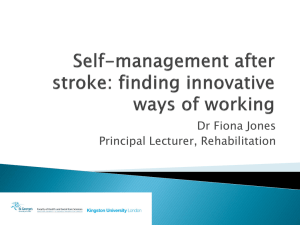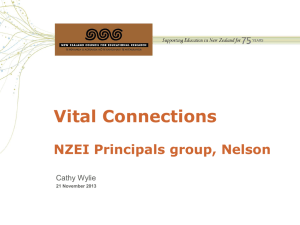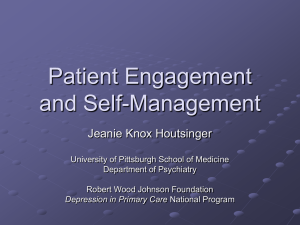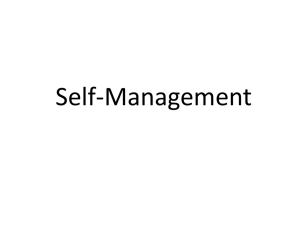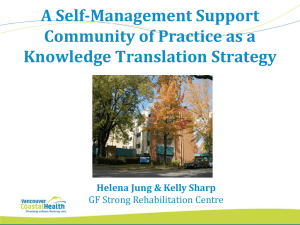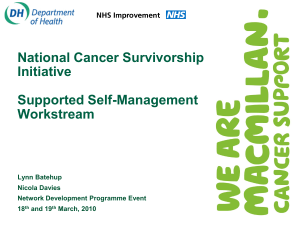Self-management support
advertisement
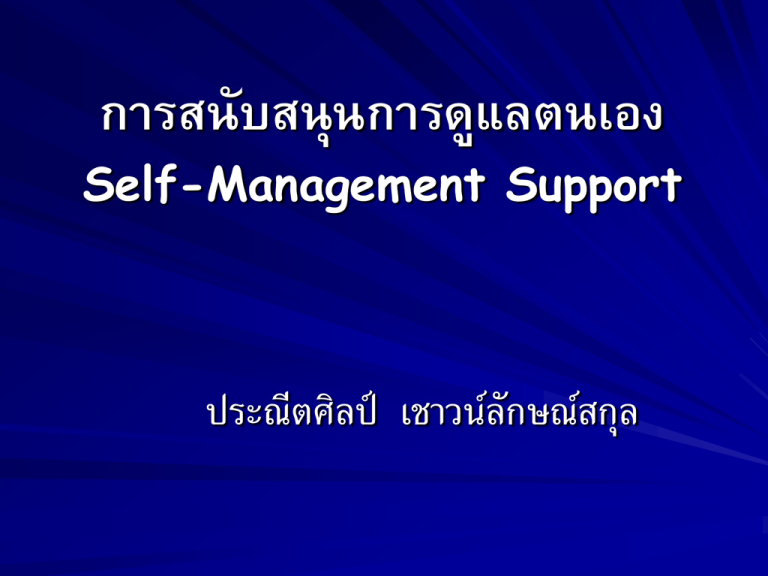
การสนับสนุนการดูแลตนเอง Self-Management Support ประณีตศิลป์ เชาวน์ลักษณ์สกุล ขอบเขตเนื้ อหา ความหมาย ความแตกต่าง (What is a difference?) – Self management (SM) VS SM Support – Traditional Health Education VS SM Education What are the existing SMS? How are the SMS effect DM outcomes? What are the predictors of SM? What are the barriers of SMS? Definitions Self care VS self-management VS self -management Support Self care หมายถึง กิจกรรมทีแ ่ ตละบุ คคล ครอบครัว ่ และชุมชน ปฏิบต ั เิ พือ ่ สรางเสริ มสุขภาพ ้ ป้องกันโรค ควบคุมการกาเริบของโรค หรือ รักษาสุขภาพ means activities that individuals, families, and communities undertake with the intention of enhancing health, preventing disease, limiting illness, and restoring health’’ (Clark, 2008). Definitions Self management VS Self Management Support “Self-management” “Day-to-day tasks that an individual must understand to control or reduce the impact of disease on physical health status. At home management tasks and strategies are undertaken with the collaboration and guidance of the individual’s physician and other health care providers” (Clark et al, 1991). Definitions “A treatment that combines biological, psychological, and social intervention techniques, with a goal of maximal functioning of regulatory processes” (Nakagawa-Kogan et al., 1988). Definitions “the individual’s ability to manage the symptoms, treatment, physical and psychosocial consequences and lifestyle changes inherent in living with a long term disorder’’ (Barlow, 2001; Department of Health England, 2005). Definitions Increasing the individual’s consumer’s capacity to engage in “activities to promote (their own) health” and empowering them to monitor and respond appropriately to the signs and symptoms related to their disease and as thus minimize the negative impact on their level of “functioning, emotions, and interpersonal relationships (Ermel, Crombie, Ham, & Bendigo Health Care Group).” Definitions “Self-management support” “activities in the clinic that prepare and empower patients to have a central role in their health care, including goal setting, action planning, problem solving, and followup” (Wagner, et al., 2001). “the process of making multi-level changes in health care systems and the community to facilitate patient self-management (Glasgow RE. et al, 2003, Rothman AA & Wagner EH., 2003 cited in Coleman & Newton, 2005). Definitions “Inter-disciplinary group education, based on the principles of adult learning, individualised treatment and case management theory” (Alderson et al., 1999). Definitions “Self-management support” 1. กิจกรรมหรือโปรแกรมทีจ ่ ด ั ขึน ้ ในคลินิกเพือ ่ เตรียม หรือเสริมกาลังให้ผู้ป่วยมีบทบาทสาคัญในการดูแล สุขภาพของตน อาทิ การตัง้ เป้าหมาย แผนปฏิบต ั ก ิ าร การแกไขปั ญหา และการ ้ ติดตาม (Wagner, et al., 2001). 2. กระบวนการของระบบบริการสุขภาพและชุมชนที่ จะกระตุนให ้ ้ผู้ป่วยดูแลตนเอง (Glasgow RE. et al, 2003, Rothman AA & Wagner EH., 2003 cited in Coleman & Newton, 2005). Definitions 3. การสอนสุขศึ กษากลุมระหว างสาขาวิ ชาชีพ ่ ่ บนหลักการเรียนรูแบบผู ใหญ เฉพาะ ้ ้ ่ รายบุคคล และการจัดการรายกรณี (Alderson et al., 1999). A concept analysis of SM Reaction of diagnosed Reactions to being diagnosed with a long-term condition are unpredictable. Self efficacy Resource use Collaboration Education Problem solving and decisionmaking Goal setting and monitoring (Embrey, 2006) • Empowerment • Development of competencies that allow people to gain control • Improved health outcomes • Increased selfconfidence What is a difference? Diabetes Education (Didactic Education) SMS Education • What is taught ? • How are problems formulated? • Relation of education to the disease •What is the relationship between patient and health professionals? • What is the theory underlying the education? • Who is the educator? • What is the goal? Table 2. Comparison of Traditional Patient Education and Self-management Education Issue Traditional Patient SelfEducation management Education สอนอะไร? ข้อมูล โรค และการ แก้ไขปั ญหา ทักษะในการจัดการ กับปั ญหา What is taught? Information and technical skills about the disease Solution to their problems Skills on how to act on problems Basic problemsolving skills (Lorig, 2003) (Lorig, 2003) (Bodenheimer, Lorig, Holman, & Grumbach, 2002) Table 2. Comparison of Traditional Patient Education and Self-management Education Issue ปั ญหามา จากไหน ? Traditional Patient Education Self-management Education การรักษาโรค ผูป้ ่ วยบอกปั ญหาที่เขา ไม่ดีพอ พบอาจจะไม่เกีย่ วกับโรค How are Problems problems reflect formulated? inadequate control of the disease The patient identifies problems he/she experiences that may or may not be related to the disease (Bodenheimer, Lorig, Holman, & Grumbach, 2002) Table 2. Comparison of Traditional Patient Education and Self-management Education Issue Traditional Self-management Patient Education Education ความสัมพันธ์ เกีย่ วกับโรค การให้สุขศึกษา Education is กับโรค disease-specific Relation of education to the disease and teaches information and technical skills related to the disease สอนทักษะการแก้ไขปั ญหาที่ เกิดตามมากับอาการเรื้ อรัง Education provides problem-solving skills that are relevant to the consequences of chronic conditions in general (Bodenheimer, Lorig, Holman, & Grumbach, 2002) Table 2. Comparison of Traditional Patient Education and Self-management Education Issue Traditional Patient Education Self-management Education ่ ป้ ่ วย ความ ความรู้หรือทฤษฏี ความรูเ้ ฉพาะโรค การ ความเชื่อมันของผู ่ ่ ปฏิบตั ิทีท่ าให้อาการดีขึ้น เชื่อมันในความสามารถของตนที ที่เกี่ยวข้ อง ? What is the theory underlying the education? Disease-specific knowledge creates behavior change, which in turn produces better clinical outcomes จะทาให้ชีวิตดีขึ้น Greater patient confidence in his/her capacity to make lifeimproving changes (self-efficacy) yields better clinical outcomes (Bodenheimer, Lorig, Holman, & Grumbach, 2002) Table 2. Comparison of Traditional Patient Education and Self-management Education Issue เป้าหมายคือ อะไร ? What is the goal? Traditional Patient SelfEducation management Education ให้ทาตาม... Compliance with the behavior changes taught to the patient to improve clinical outcomes เพิม่ ความมันใจว่ ่ าตน จะดูแลตนเองได้ Increased selfefficacy to improve clinical outcomes (Bodenheimer, Lorig, Holman, & Grumbach, 2002) Table 2. Comparison of Traditional Patient Education and Self-management Education Issue Who is the educator? Traditional Patient Education A health professional Self-management Education A health professional, peer leader, or other patients, often in group settings (Bodenheimer, Lorig, Holman, & Grumbach, 2002) Table 1. Comparison of Traditional and Collaborative Care in Chronic Illness Issue What is the relationship between patient and health professionals? Traditional Care Collaborative-C Professionals are the experts who tell patients what to do. Patients are passive. Shared expertise with active patients. Professionals are experts about the disease and patients are experts about their lives. Table 1. Comparison of Traditional and Collaborative Care in Chronic Illness Issue Who is the principal caregiver and problem solver? Who is responsible for outcomes? Traditional Care Collaborative-C The professional. The patient and professional are the principal caregivers; they share responsibility for solving problems and for outcomes. Table 1. Comparison of Traditional and Collaborative Care in Chronic Illness Issue Traditional Care What is Compliance with the goal? instructions. Noncompliance is a personal deficit of the patient. Collaborative-C The patient sets goals and the professional helps the patient make informed choices. Lack of goal achievement is a problem to be solved by modifying strategies. Table 1. Comparison of Traditional and Collaborative Care in Chronic Illness Issue How is behavior changed? Traditional Care Collaborative-C External Internal motivation. motivation. Patients gain understanding and confidence to accomplish new behaviors. (Bodenheimer, Lorig, Holman, & Grumbach, 2002) Table 1. Comparison of Traditional and Collaborative Care in Chronic Illness Issue How are problems identified? Traditional Care By the professional, e.g, changing unhealthy behaviors. Collaborative-C By the patient, e.g, pain or inability to function; and by the professional. (Bodenheimer, Lorig, Holman, & Grumbach, 2002) Table 1. Comparison of Traditional and Collaborative Care in Chronic Illness Issue How are problems solved? Traditional Care Professionals solve problems for patients. Collaborative-C Professionals teach problem-solving skills and help patients in solving problems. (Bodenheimer, Lorig, Holman, & Grumbach, 2002) DM Management Skills Problem solving – Problem definition, generation of possible solutions including the solicitation of suggestions from friends and health care professionals, solution implementation, and evaluation the results Decision making Resource utilization Forming of a patient/health care provider partnership Taking action (Lorig, 2003) DM Management Skills “ไม่ ให้ แค่ ปลา แต่ สอนวิธีการหาปลา” “วิเคราะห์ สั งเคราะห์ ตัดสิ นใจ > รู้ จา” Classifications of SM Knowledge or information Life style behaviors (diet, physical activities) Skill development (skill to improve glycemic control e.g., self – monitoring of blood glucose) Skills to prevent and identify complications (foot care) Coping skills (to improve psychosocial function e.g., intervention that used empowerment techniques or promoted relaxation or selfefficacy) (Norris, Lau, Smith, Schmid, & Engelgau, 2002) Long term, continuous FU, supporting The Predictors of SMS Meta-regression – Duration of contact time between educator and patient was the only significant predictor of effect with 23.6 hours of contact time needed for each 1% absolute decreased in GHb (Norris, Lau, Smith, Schmid, & Engelgau, 2002) SMS Processes Patients Providers •Physician Problem-based solving Goals setting & Plans Glycemic control Education& Empower SM Behaviors Topics-ADA Types • Group •Nurses • Individual •Dietician • Group discussion •Pharmacist Supports •Physiotherapist • FU-Phone/Visit •Others • Resources use Evaluation & Feedback Nutrition Exercise Medication Selfmonitoring Problem solving Risk reduction Psychosocial adjustment รูปแบบ self-management support The Stanford and Flinders Programs - are complimentary approaches to chronic condition self-management (CCSM). - developed by Kate Lorig and associates at Stanford University – USA. - It has been well researched for over 20 years. http://www.risen.org.au/CDSM/CDSM_Program_Flinders.asp รูปแบบ self-management support The Stanford and Flinders Programs - กิจกรรมสาคัญ ได้ แก่ - a group setting - using peer leaders and standardised structured sessions - Individuals share experiences and learn generic self-management skills and strategies that will help them help themselves. http://www.risen.org.au/CDSM/CDSM_Program_Flinders.asp รูปแบบ self-management support The Flinders Program - was developed by Malcolm Battersby and associates at the Flinders Human Behaviour and Health Research Unit (FHB&HRU) in Australia. - is a one-on-one model, with interventions /actions agreed between clinician and patient and tailored to the identified needs and priorities of the individual. http://www.risen.org.au/CDSM/CDSM_Program_Flinders.asp รูปแบบ self-management support The Flinders Program is underpinned by:- cognitive behavioural therapy (CBT) principles. - provides a structured, patient centered framework for collaborative problem definition, goal setting, care planning and review and offers a generic approach to chronic condition self-management that can be applied to a wide range of health conditions. http://www.risen.org.au/CDSM/CDSM_Program_Flinders.asp A five-component heuristic model (Glasgow, et al., 2002) The Big Bad Sugar War (BBSWAR) Figure 1. St. Peter Family Medicine Residency Program. Self-Management Goal Cycle with the Big Bad Sugar War approach to setting goals. (Langford, Sawyer, Gioimo, Brownson, & O'Toole, 2007) Background: find out about the patient, how they view their disease, what is concerning them, what support they have at home, how well they are managing, and so forth. Barriers: explore what has not worked well in the past for the patient and what makes it difficult to make lifestyle changes such as healthy food choices and physical activity. Successes: focus on what a patient has done well, and celebrate their accomplishments no matter how small they may seen. (Langford, Sawyer, Gioimo, Brownson, & O'Toole, 2007) Willingness to change: once you know the patient’s background and have explored barriers and celebrated successes, find a behavior that he or she is willing to change. Action plan: coach the patient to set a specific and detailed goal that is important to him or her. Write down the goal, and give the patient a copy. Reinforce and remember: conduct telephone follow-up to provide encouragement and motivation. Refine, redefine, or stretch the goal at the next MA planned visit, provider visit, or group visit. It is vital for the health care team to remember patient goals and incorporate them into conversations at each visit. (Langford, Sawyer, Gioimo, Brownson, & O'Toole, 2007) Goal setting Supports Planed visit = routine health checks and laboratory tests prior to traditional individual appointments Mini-group medical visits = a provider and medical assistant meet with 3 patients at one time Open office group visits = 7-12 patients attend 2-hour sessions staffed by a provider (Langford, Sawyer, Gioimo, Brownson, & O'Toole, 2007) Self-management support Assessment, not only knowledge but needs to know more about what patients value and what they do. Advice, needs to link to scientific evidence, not provider biases Agree, on shared goals Assist, by identifying barriers and problem-solving to deal with them Arrange, a specific follow up plan

